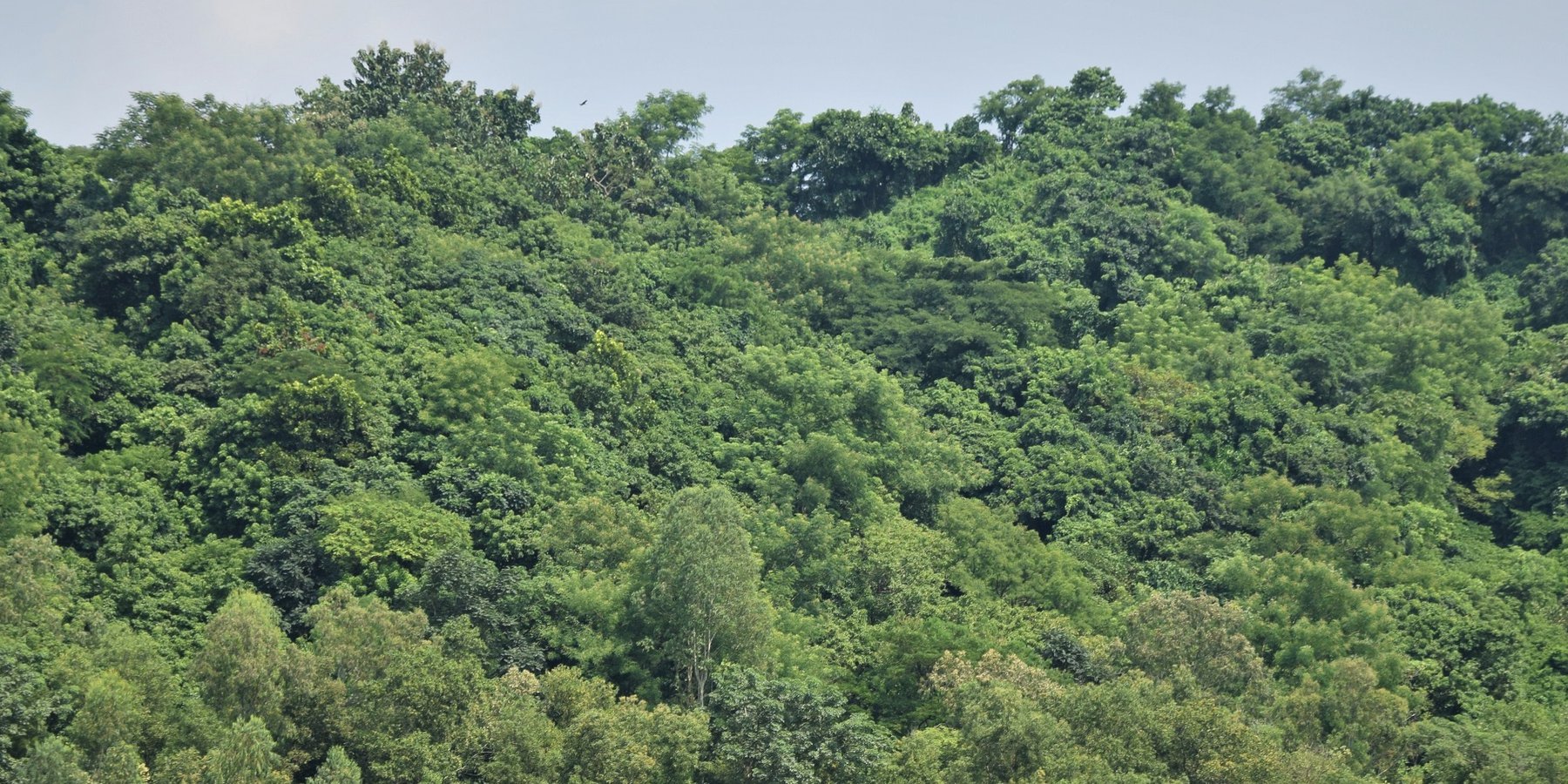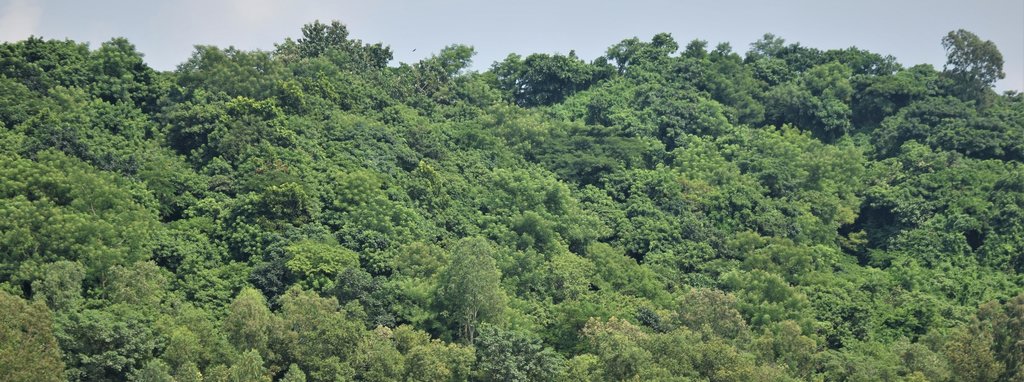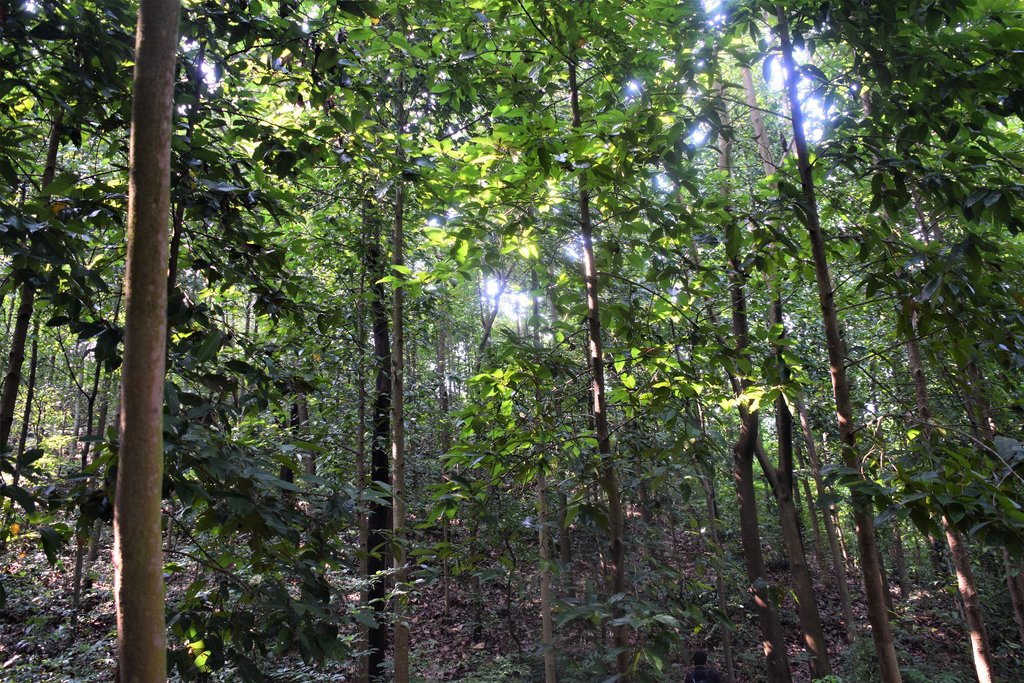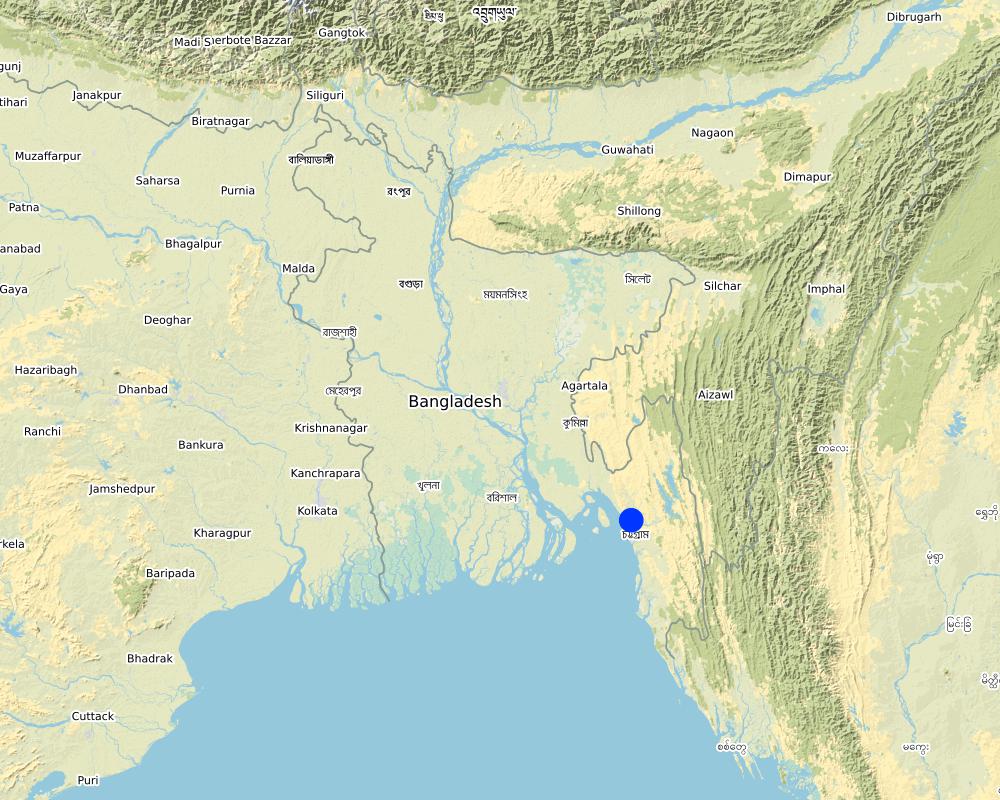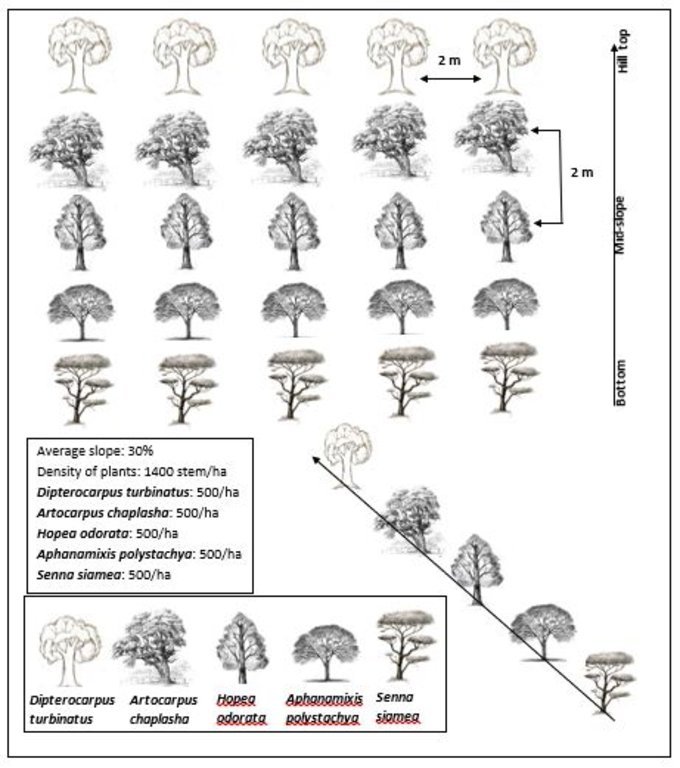Mixed plantation with slow growing indigenous species to protect land degradation [ប្រទេសបង់ក្លាដែស]
- ការបង្កើត៖
- បច្ចុប្បន្នភាព
- អ្នកចងក្រង៖ Fazlay Arafat
- អ្នកកែសម្រួល៖ –
- អ្នកត្រួតពិនិត្យច្រើនទៀត៖ Nicole Harari, Rima Mekdaschi Studer, Ursula Gaemperli
Desi Projatir Misro Bagan
technologies_4329 - ប្រទេសបង់ក្លាដែស
ពិនិត្យមើលគ្រប់ផ្នែក
ពង្រីកមើលទាំងអស់ បង្រួមទាំងអស់1. ព័ត៌មានទូទៅ
1.2 ព័ត៌មានលម្អិតពីបុគ្គលសំខាន់ៗ និងស្ថាប័នដែលចូលរួមក្នុងការវាយតម្លៃ និងចងក្រងឯកសារនៃបច្ចេកទេស
បុគ្គលសំខាន់ម្នាក់ (ច្រើននាក់)
អ្នកប្រើប្រាស់ដី:
Hossain Md. Akhter
Institute of Forestry and Environmental Sciences, University of Chittagong
ប្រទេសបង់ក្លាដែស
អ្នកប្រើប្រាស់ដី:
Alam Md. Bodiul
University of Chittagong
ប្រទេសបង់ក្លាដែស
ឈ្មោះគម្រោងដែលបានចងក្រងឯកសារ/ វាយតម្លៃលើបច្ចេកទេស (បើទាក់ទង)
Decision Support for Mainstreaming and Scaling out Sustainable Land Management (GEF-FAO / DS-SLM)ឈ្មោះអង្គភាពមួយ (ច្រើន) ដែលបានចងក្រងឯកសារ/ វាយតម្លៃបច្ចេកទេស (បើទាក់ទង)
Bangladesh Forest Department (Bangladesh Forest Department) - ប្រទេសបង់ក្លាដែស1.3 លក្ខខណ្ឌទាក់ទងទៅនឹងការប្រើប្រាស់ទិន្នន័យដែលបានចងក្រងតាមរយៈ វ៉ូខេត
អ្នកចងក្រង និង(បុគ្គលសំខាន់ៗ)យល់ព្រមទទួលយកនូវលក្ខខណ្ឌនានាទាក់ទងទៅនឹងការប្រើប្រាស់ទិន្នន័យដែលបានចងក្រងតាមរយៈវ៉ូខេត:
បាទ/ចា៎
1.4 សេចក្តីប្រកាសស្តីពីចីរភាពនៃការពណ៌នាពីបច្ចេកទេស
តើបច្ចេកទេសដែលបានពណ៌នានេះមានបញ្ហាដែលផ្តោតលើការធ្លាក់ចុះគុណភាពដី, បើដូច្នេះវាមិនអាចត្រូវបានប្រកាសថាជាបច្ចេកទេសនៃការគ្រប់គ្រងប្រកបដោយចីរភាពទេ?
ទេ
2. ការពណ៌នាពីបច្ចេកទេស SLM
2.1 ការពណ៌នាដោយសង្ខេបពីបច្ចេកទេស
និយមន័យបច្ចេកទេស:
Mixed plantation technique with slow growing indigenous plant species in hill slope, that plays an important role to protect land degradation.
2.2 ការពណ៌នាលម្អិតពីបច្ចេកទេស
ការពណ៌នា:
Mixed-species plantations can play an important role in regulating land degradation and sustainable management of degraded forest areas. Among the various forestry practices, planting fast-growing species (used in mono-culture plantation) with slow-growing and indigenous species has a positive long-term impact on forest land management. Mixed species tree plantations have the potential to improve forest soils, forest cover and biological diversity, and facilitate forest succession in degraded ecosystems. In addition to carbon accumulation, mixed plantations also increase understory plant regeneration, and in some cases, reduce diseases and pests infestation in plantation. This technology is applied in hill-forest areas in Bangladesh for preventing erosion and risk of landslides, and to provide a sustainable supply of timber and fuel wood.
The plantation site located in Hathazari area of Chittagong division and inside the periphery of University of Chittagong. The landform is hill slope with 16-30% slopes on average. The annual rainfall is around 2500 mm and the soil texture is loamy to silty. The species used at the Hathazari plantation site were: Garjan (Dipterocarpus turbinatus), Telsur (Hopea odorata), Chapalish (Artocarpus chaplasha), Pithraj (Aphanamixis polystachya), and Minjiri (Senna siamea). All are deep-rooted, slow growing indigenous plant species with a felling rotation of 25-30 years. The Dipterocarpus species grows well on top of hill whereas Artocarpus chaplasha and Hopea odorata grows well in mid slope. Aphanamixis polystachya and Senna siamea perform well in bottom layer of hill. The sequence has positive mutual effects on tree growing. The plantation was established and managed by the authority of University of Chittagong (owner of the land) in 1990 with 2500 trees planted per hectare area (spacing interval 2m x 2m). The average slope of the site is around 30%. Before reforestation, the land was degraded and unproductive. As only a few scattered trees grow due to a huge demand of fuel wood the resulting insufficient coverage by tree crowns frequently led to landslides in the area. The local communities are only allowed to collect the dead branches as fuel and other non-wood forest products like honey, mushrooms, fruits and fodders from the plantation site.
The major activities required to establish the plantation are: seed collection, nursery preparation, site preparation, pit preparation, planting, tying of plants to stick for support, application of fertilizer, compost and biocide. After first establishment, the plantation needs ongoing maintenance activities such as weeding, refilling of vacancies, thinning, pruning, application of fertilizers and biocides (if necessary) and cutting of climbers. The timber species undergo a variety of thinning practices before the entire stand reaches maturity. These trees are progressively thinned out to provide fuel wood and timber, while allowing room for the natural regeneration of native species. The university authority carried out the maintenance activities and such a practice is advantageous to adjacent local communities since it meets their fuel wood demand.
Prior to establishment of the plantation, the area was barren and unproductive, and was hardly a suitable habitat for wildlife. More critically, during the annual monsoons, landslides were a regular phenomenon. The natural regeneration of the deforested area was additionally hampered by incendiary fires set by local communities for agricultural purpose. After the establishment of the plantation and the subsequent improvement of forest/land cover, it is now a habit for various species of bird, monkeys, deer, wild pigs, and rabbits. Furthermore, in humid tropical regions like Bangladesh, the frequent litterfall from indigenous plant species in mixed plantations constitutes the bulk of soil organic matter, and improved nutrient availability and soil fertility.
Though the mixed plantation required intensive management in the early stage, the example of this plantation shows that the mixed plantation with indigenous species is worthwhile and a degraded area can fully recover after 20 years. However, illicit felling of timber trees and illegal removal of litters from the ground for fuel by the local communities are still remains as a management challenge. The practice retains ecological integrity and enhances human well-being (through ‘cultural’ ecosystem services such as aesthetic beauty, ecotourism etc.) and livelihood (timber, fuelwood, non-timber forest products) as well.
2.3 រូបភាពនៃបច្ចេកទេស
2.5 ប្រទេស/តំបន់/ទីតាំងកន្លែង ដែលបច្ចេកទេសត្រូវបានអនុវត្ត និងបានគ្រប់ដណ្តប់ដោយការវាយតម្លៃនេះ
ប្រទេស:
ប្រទេសបង់ក្លាដែស
តំបន់/រដ្ឋ/ខេត្ត:
Chittagong division
បញ្ជាក់បន្ថែមពីលក្ខណៈនៃទីតាំង:
Hathazari
បញ្ជាក់ពីការសាយភាយនៃបច្ចេកទេស:
- ត្រូវបានផ្សព្វផ្សាយត្រឹមតំបន់មួយ
ប្រសិនបើមិនច្បាស់ពីទំហំផ្ទៃដី សូមធ្វើការប៉ាន់ប្រម៉ាណ:
- 0.1-1 គម2
តើបច្ចេកទេស (មួយ ឬច្រើន) ទាំងនោះស្ថិតនៅក្នុងតំបន់ការពារជាអចិន្ត្រៃយ៍ណាមួយដែរឬទេ?
ទេ
Map
×2.6 កាលបរិច្ឆេទនៃការអនុវត្ត
បង្ហាញឆ្នាំនៃការចុះអនុវត្ត:
1990
2.7 ការណែនាំពីបច្ចេកទេស
សូមបញ្ជាក់តើបច្ចេកទេសត្រូវបានណែនាំឱ្យអនុវត្តដោយរបៀបណា:
- ពេលកំពុងពិសោធន៍
3. ចំណាត់ថ្នាក់នៃបច្ចេកទេស SLM
3.1 គោលបំណងចម្បង (១ ឬច្រើន) នៃបច្ចេកទេសនេះ
- ធ្វើឱ្យប្រសើរឡើងនូវផលិតកម្ម
- កាត់បន្ថយ, បង្ការ, ស្តារឡើងវិញនូវការធ្លាក់ចុះគុណភាពដី
- អភិរក្សប្រព័ន្ធអេកូឡូស៊ី
- កាត់បន្ថយហានិភ័យនៃគ្រោះមហន្តរាយ
- បង្កើតផលប្រយោជន៍សង្គម
3.2 ប្រភេទដីប្រើប្រាស់មួយប្រភេទ (ច្រើនប្រភេទ) ដែលបានអនុវត្តបច្ចេកទេស
ដីប្រើប្រាស់ចម្រុះនៅលើដីតែមួយ:
ទេ

ដីព្រៃ/ដីដាំដើមឈើ
- ការដាំដើមឈើ ការដាំព្រៃឡើងវិញ
ការដាំដើមឈើ ការដាំដើមឈើឡើងវិញ៖ បញ្ជាក់ពីប្រភេទក្នុងតំបន់ និងប្រភេទលុប:
- ពូជបញ្ចូលគ្នា
ប្រភេទដើមឈើដែលដាំនៅកន្លែងដែលមិនធ្លាប់មានឈើពីមុន :
- ព្រៃដាំរងទឹកភ្លៀងតំបន់ត្រូពិច
- Garjan (Dipterocarpus turbinatus), Telsur (Hopea odorata), Chapalish (Artocarpus Chaplasha), Pithraj (Aphanamixis polystachya), Minjiri (Senna siamea), etc.
តើប្រភេទឈើខាងលើជាប្រភេទឈើក្នុងព្រៃល្បោះ ឬស្រោង?
- ព្រៃល្បោះចម្រុះ/ ព្រៃស្រោង
ផលិតផល និងសេវាកម្ម:
- ឈើហ៊ុប
- អុស
- ការអភិរក្ស/ការការពារធម្មជាតិ
- ការកំសាន្ត/ទេសចរណ៍
- ការពារពីគ្រោះធម្មជាតិ
3.3 បន្ទាប់ពីអនុវត្តបច្ចេកទេស តើដីប្រើប្រាស់មានការប្រែប្រួលដែររឺទេ?
បន្ទាប់ពីអនុវត្តបច្ចេកទេស តើដីប្រើប្រាស់មានការប្រែប្រួលដែររឺទេ?
- បាទ/ច៎ា (សូមបំពេញសំណួរខាងក្រោមពីស្ថានភាពដីប្រើប្រាស់មុនពេលអនុវត្តបច្ចេកទេស)
ដីប្រើប្រាស់ចម្រុះនៅលើដីតែមួយ:
ទេ

ដីខ្សោះជីជាតិ
សូមបញ្ជាក់:
The area was unproductive with some scatter trees that grows naturally. Due to huge demand of fuel wood the few natural stands also faced tremendous pressure. As the canopy coverage was exposed, landslides occurred frequently in that area.
3.4 ការផ្គត់ផ្គង់ទឹក
ការផ្គត់ផ្គង់ទឹកនៅកន្លែងអនុវត្តបច្ចេកទេស:
- ទឹកភ្លៀង
3.5 ក្រុម SLM ដែលបច្ចេកទេសស្ថិតនៅក្នុង
- គ្រប់គ្រងការដាំព្រៃឈើ
- ធ្វើឱ្យប្រសើរឡើងគម្របដី/ ដំណាំគម្របដី
- កាត់បន្ថយហានិភ័យនៃបញ្ហាលើប្រព័ន្ធអេកូឡូស៊ី
3.6 វិធានការ SLM ដែលបញ្ចូលនូវបច្ចេកទេស

វិធានការរុក្ខជាតិ
- V1: ឈើធំៗ និងដើមឈើតូចៗ
3.7 កំណត់ប្រភេទនៃការធ្លាក់ចុះគុណភាពដីសំខាន់ៗដែលបច្ចេកទេសនេះបានដោះស្រាយ

ការហូរច្រោះដីដោយសារទឹក
- Wt: ការបាត់ដីស្រទាប់លើដោយការហូរច្រោះ
- Wg: ការកកើតឡើងនូវកំទេចកំទីដីស្រទាប់ក្រោម
- Wm: ការបាក់ដី
3.8 ការពារ កាត់បន្ថយ ឬស្តារឡើងវិញនៃការធ្លាក់ចុះគុណភាពដី
បញ្ជាក់ពីគោលដៅរបស់បច្ចេកទេស ដែលផ្តោតទៅការធ្លាក់ចុះគុណភាពដី:
- ការកាត់បន្ថយការធ្លាក់ចុះគុណភាពដី
4. បច្ចេកទេសជាក់លាក់ សកម្មភាពអនុវត្ត ធាតុចូល និងថ្លៃដើម
4.1 គំនូសបច្ចេកទេសនៃបច្ចេកទេសនេះ
លក្ខណៈពិសេសនៃបច្ចេកទេស (ទាក់ទងនឺងគំនូរបច្ចេកទេស):
The dimensions of structures are explained in the description part.
ឈ្មោះអ្នកនិពន្ធ:
Md. Fazlay Arafat
កាលបរិច្ឆេទ:
13/09/2018
4.2 ព័ត៌មានទូទៅដែលពាក់ព័ន្ធនឹងការគណនាធាតុចូល និងថ្លៃដើម
កំណត់របៀបនៃការគណនាថ្លៃដើម និងធាតុចូល:
- ក្នុងតំបន់អនុវត្តបច្ចេកទេស
កំណត់ទំហំ និងឯកត្តាផ្ទៃដី:
hectare
បើសិនប្រើឯកតាតាមតំបន់ សូមបញ្ជាក់តម្លៃបម្លែងវាទៅជាហិកតា (ឧ. 1 ហិកតា = 2.47 អា)៖ 1 ហិកតា =:
2.47 acres
ផ្សេងៗ/ រូបិយប័ណ្ណជាតិ (បញ្ជាក់):
BDT
បើពាក់ព័ន្ធសូមកំណត់អត្រាប្តូរប្រាក់ពីដុល្លាទៅរូបិយប័ណ្ណតំបន់ (ឧ. 1 ដុល្លារ = 79.9 រៀលនៃរូបិយប័ណ្ណប្រេស៊ីល) ៖ 1 ដុល្លារ =:
83,0
កំណត់ថ្លៃឈ្នួលជាមធ្យមនៃការជួលកម្លាំងពលកម្មក្នុងមួយថ្ងៃ:
500
4.3 សកម្មភាពបង្កើត
| សកម្មភាព | រយៈពេល (រដូវកាល) | |
|---|---|---|
| 1. | Nursery preparation (seed collection, site clearing, leveling and fencing, drainage arrangement, bed preparation, making overhead shed, poly-bag preparation, potting seeds, manuring, irrigation, weed control) | October |
| 2. | Site preparation (prepare plantation site map with GPS, jungle cutting, debris collection and staging, preparation of inspection paths and fire lines) | May |
| 3. | Plantation (pit preparation, tying up of plants, application of fertilizers, compost and biocide, stick for support) | June-July |
4.4 ថ្លៃដើម និងធាតុចូលដែលត្រូវការសម្រាប់ការបង្កើតបច្ចេកទេស
| បញ្ជាក់ពីធាតុចូល | ឯកតា | បរិមាណ | ថ្លៃដើមក្នុងមួយឯកតា | ថ្លៃធាតុចូលសរុប | % នៃថ្លៃដើមដែលចំណាយដោយអ្នកប្រើប្រាស់ដី | |
|---|---|---|---|---|---|---|
| កម្លាំងពលកម្ម | Nursery work | Person day | 32,0 | 500,0 | 16000,0 | 100,0 |
| កម្លាំងពលកម្ម | Site preparation | Person day | 20,0 | 500,0 | 10000,0 | 100,0 |
| កម្លាំងពលកម្ម | Plantation | Person day | 40,0 | 500,0 | 20000,0 | 100,0 |
| សម្ភារៈ | Polybags | Pieces | 3000,0 | 1,0 | 3000,0 | 100,0 |
| សម្ភារៈ | Loamy soil | Cubic meter | 6,0 | 400,0 | 2400,0 | 100,0 |
| សម្ភារៈ | Bamboo | Pieces | 7,0 | 600,0 | 4200,0 | 100,0 |
| សម្ភារៈ | Stick | Pieces | 2600,0 | 2,0 | 5200,0 | 100,0 |
| សម្ភារៈ | Rope | Lump sum | 1,0 | 200,0 | 200,0 | 100,0 |
| សម្ភារៈ | Bucket, Spade, Knife | Lump sum | 1,0 | 1000,0 | 1000,0 | 100,0 |
| សម្ភារៈដាំដុះ | Seeds | Kg | 2,0 | 500,0 | 1000,0 | 100,0 |
| ជី និងសារធាតុពុល | Urea | Kg | 12,0 | 35,0 | 420,0 | 100,0 |
| ជី និងសារធាតុពុល | TSP | Kg | 12,0 | 40,0 | 480,0 | 100,0 |
| ជី និងសារធាតុពុល | MoP | Kg | 12,0 | 30,0 | 360,0 | 100,0 |
| ជី និងសារធាតុពុល | Compost | Kg | 3200,0 | 4,0 | 12800,0 | 100,0 |
| ជី និងសារធាតុពុល | Biocide | Lump Sum | 1,0 | 200,0 | 200,0 | 100,0 |
| សម្ភារៈសាងសង់ | Signboard (to demarcate plantation area, number of species planted and year of plantation) | Pieces | 1,0 | 1000,0 | 1000,0 | 100,0 |
| ថ្លៃដើមសរុបក្នុងការបង្កើតបច្ចេកទេស | 78260,0 | |||||
| ថ្លៃដើមសរុបក្នុងការបង្កើតបច្ចេកទេសគិតជាដុល្លារ | 942,89 | |||||
មតិយោបល់:
The University of Chittagong is the land user here.
4.5 សកម្មភាពថែទាំ
| សកម្មភាព | ពេលវេលា/ ភាពញឹកញាប់ | |
|---|---|---|
| 1. | 1st year weeding and climber cutting | 3 times in a year |
| 2. | 2nd year weeding, climber cutting and thinning | 3 times in a year |
| 3. | 3rd year weeding, climber cutting, thinning and pruning | 3 times in a year |
| 4. | 1st year Vacancy filling, fertilizer and compost application | June-July |
| 5. | 2nd year Vacancy filling, fertilizer and compost application | June-July |
4.6 កំណត់ថ្លៃដើមសម្រាប់ការថែទាំ/ សកម្មភាពរបស់បច្ចេកទេស (ក្នុងរយៈពេលមួយឆ្នាំ)
| បញ្ជាក់ពីធាតុចូល | ឯកតា | បរិមាណ | ថ្លៃដើមក្នុងមួយឯកតា | ថ្លៃធាតុចូលសរុប | % នៃថ្លៃដើមដែលចំណាយដោយអ្នកប្រើប្រាស់ដី | |
|---|---|---|---|---|---|---|
| កម្លាំងពលកម្ម | 1st year weeding and climber cutting | person-day | 21,0 | 500,0 | 10500,0 | 100,0 |
| កម្លាំងពលកម្ម | 2nd year weeding, climber cutting and thinning | person-day | 21,0 | 500,0 | 10500,0 | 100,0 |
| កម្លាំងពលកម្ម | 3rd year weeding, climber cutting, thinning and pruning | person-day | 12,0 | 500,0 | 6000,0 | 100,0 |
| កម្លាំងពលកម្ម | Vacancy filling, fertilizer and compost application 2 times | person-day | 30,0 | 500,0 | 15000,0 | 100,0 |
| សម្ភារៈដាំដុះ | Seedlings | pieces | 500,0 | 10,0 | 5000,0 | 100,0 |
| ជី និងសារធាតុពុល | Urea, TSP, MoP, Compost | Lump sum | 1,0 | 1000,0 | 1000,0 | 100,0 |
| ថ្លៃដើមសរុបសម្រាប់ការថែទាំដំណាំតាមបច្ចេកទេស | 48000,0 | |||||
| ថ្លៃដើមសរុបសម្រាប់ការថែទាំដំណាំតាមបច្ចេកទេសគិតជាដុល្លារ | 578,31 | |||||
4.7 កត្តាសំខាន់បំផុតដែលមានឥទ្ធិពលដល់ការចំណាយ
ពណ៌នាពីកត្តាប៉ះពាល់ចម្បងៗទៅលើថ្លៃដើម:
Labor cost
5. លក្ខណៈបរិស្ថានធម្មជាតិ និងមនុស្ស
5.1 អាកាសធាតុ
បរិមាណទឹកភ្លៀងប្រចាំឆ្នាំ
- < 250 មម
- 251-500 មម
- 501-750 មម
- 751-1,000 មម
- 1,001-1,500 មម
- 1,501-2,000 មម
- 2,001-3,000 មម
- 3,001-4,000 មម
- > 4,000 មម
តំបន់កសិអាកាសធាតុ
- សើម
5.2 សណ្ឋានដី
ជម្រាលជាមធ្យម:
- រាបស្មើ (0-2%)
- ជម្រាលតិចតួច (3-5%)
- មធ្យម (6-10%)
- ជម្រាលខ្ពស់បន្តិច (11-15%)
- ទីទួល (16-30%)
- ទីទួលចោត (31-60%)
- ទីទួលចោតខ្លាំង (>60%)
ទម្រង់ដី:
- ខ្ពង់រាប
- កំពូលភ្នំ
- ជម្រាលភ្នំ
- ជម្រាលទួល
- ជម្រាលជើងភ្នំ
- បាតជ្រលងភ្នំ
តំបន់តាមរយៈកម្ពស់ :
- 0-100 ម
- 101-500 ម
- 501-1,000 ម
- 1,001-1,500 ម
- 1,501-2,000 ម
- 2,001-2,500 ម
- 2,501-3,000 ម
- 3,001-4,000 ម
- > 4,000 ម
បញ្ជាក់ថាតើបច្ចេកទេសនេះត្រូវបានអនុវត្តន៍នៅក្នុង:
- មិនពាក់ព័ន្ធទាំងអស់
5.3 ដី
ជម្រៅដីជាមធ្យម:
- រាក់ខ្លាំង (0-20 សម)
- រាក់ (21-50 សម)
- មធ្យម (51-80 សម)
- ជ្រៅ (81-120 សម)
- ជ្រៅខ្លាំង (> 120 សម)
វាយនភាពដី (ស្រទាប់លើ):
- មធ្យម (ល្បាយ, ល្បាប់)
វាយនភាពដី (> 20 សម ស្រទាប់ក្នុង):
- មធ្យម (ល្បាយ, ល្បាប់)
សារធាតុសរីរាង្គនៅស្រទាប់ដីខាងលើ:
- មធ្យម (1-3%)
5.4 ទឹកដែលអាចទាញមកប្រើប្រាស់បាន និងគុណភាពទឹក
នីវ៉ូទឹកក្រោមដី:
5-50 ម
ទឹកលើដីដែលអាចទាញយកប្រើប្រាស់បាន:
កម្រិតមធ្យម
គុណភាពទឹក (មិនបានធ្វើប្រត្តិកម្ម):
ទឹកពិសារដែលគ្មានគុណភាព (តម្រូវឱ្យមានការសំអាត)
គុណភាពទឹក គឺផ្តោតទៅលើ៖:
ទឹកលើផ្ទៃដី
តើមានបញ្ហាភាពទឹកប្រៃហូរចូលមកដែរឬទេ?
ទេ
តើទឹកជំនន់កំពុងកើតមាននៅតំបន់នេះដែររឺទេ?
ទេ
5.5 ជីវៈចម្រុះ
ភាពសម្បូរបែបនៃប្រភេទ:
- កម្រិតមធ្យម
ភាពសម្បូរបែបនៃទីជម្រក:
- ទាប
5.6 លក្ខណៈនៃអ្នកប្រើប្រាស់ដីដែលអនុវត្តបច្ចេកទេស
នៅមួយកន្លែង ឬពនេចរ :
- នៅមួយកន្លែង
ទីផ្សារនៃប្រព័ន្ធផលិតកម្ម:
- ពាក់កណ្តាលពាណិជ្ជកម្ម (ផ្គត់ផ្គង់ខ្លួនឯង/ ពាណិជ្ជកម្ម)
ចំណូលក្រៅកសិកម្ម:
- តិចជាង 10% នៃចំណូល
កម្រិតជីវភាព:
- មធ្យម
ឯកជន ឬក្រុម:
- មានបុគ្គលិក (ក្រុមហ៊ុន, រដ្ឋ)
កម្រិតប្រើប្រាស់គ្រឿងយន្ត:
- ប្រើកម្លាំងពលកម្ម
យេនឌ័រ:
- ស្ត្រី
- បុរស
អាយុរបស់អ្នកប្រើប្រាស់ដី:
- យុវវ័យ
- វ័យកណ្តាល
5.7 ទំហំផ្ទៃដីជាមធ្យមនៃដីប្រើប្រាស់ដោយអ្នកប្រើប្រាស់ដី ក្នុងការអនុវត្តបច្ចេកទេស
- < 0.5 ហិកតា
- 0.5-1 ហិកតា
- 1-2 ហិកតា
- 2-5 ហិកតា
- 5-15 ហិកតា
- 15-50 ហិកតា
- 50-100 ហិកតា
- 100-500 ហិកតា
- 500-1,000 ហិកតា
- 1,000-10,000 ហិកតា
- > 10,000 ហិកតា
តើផ្ទៃដីនេះចាត់ទុកជាទំហំកម្រិតណាដែរ ខ្នាតតូច មធ្យម ឬខ្នាតធំ (ធៀបនឹងបរិបទតំបន់)?
- ខ្នាតមធ្យម
5.8 ភាពជាម្ចាស់ដី កម្មសិទ្ធប្រើប្រាស់ដី និងកម្មសិទ្ធប្រើប្រាស់ទឹក
ភាពជាម្ចាស់ដី:
- រដ្ឋ
កម្មសិទ្ធិប្រើប្រាស់ដី:
- ឯកជន
កម្មសិទ្ធប្រើប្រាស់ទឹក:
- អាស្រ័យផលសេរី (មិនមានការកំណត់)
តើកម្មសិទ្ធប្រើប្រាស់ដី គឺផ្អែកលើប្រព័ន្ធច្បាប់បែបបុរាណ?
ទេ
5.9 ការប្រើប្រាស់សេវាកម្ម និងហេដ្ឋារចនាសម្ព័ន្ធ
សុខភាព:
- មិនល្អ
- មធ្យម
- ល្អ
ការអប់រំ:
- មិនល្អ
- មធ្យម
- ល្អ
ជំនួយបច្ចេកទេស:
- មិនល្អ
- មធ្យម
- ល្អ
ការងារ (ឧ. ការងារក្រៅកសិដ្ឋាន):
- មិនល្អ
- មធ្យម
- ល្អ
ទីផ្សារ:
- មិនល្អ
- មធ្យម
- ល្អ
ថាមពល:
- មិនល្អ
- មធ្យម
- ល្អ
ផ្លូវ និងការដឹកជញ្ជូន:
- មិនល្អ
- មធ្យម
- ល្អ
ទឹកផឹក និងអនាម័យ:
- មិនល្អ
- មធ្យម
- ល្អ
សេវាកម្មហិរញ្ញវត្ថុ:
- មិនល្អ
- មធ្យម
- ល្អ
6. ផលប៉ះពាល់ និងការសន្និដ្ឋាន
6.1 ផលប៉ះពាល់ក្នុងបរិវេណអនុវត្តបច្ចេកទេសដែលកើតមាន
ផលប៉ះពាល់លើសេដ្ឋកិច្ចសង្គម
ផលិតផល
ផលិតកម្មឈើ
គុណភាពព្រៃឈើ/ដីព្រៃ
អនុផលព្រៃឈើ
មតិយោបល់/ ការបញ្ជាក់:
honey, mushrooms and fruits for wildlife
ហានិភ័យនៃភាពបរាជ័យរបស់ផលិតកម្ម
មតិយោបល់/ ការបញ្ជាក់:
mixed plantation is more pest resistant
ភាពសម្បូរបែបនៃផលិតផល
មតិយោបល់/ ការបញ្ជាក់:
Along with timber these mixed plantation yields oil, fruits, fodder, fuel and herbal medicines
ផ្ទៃដីផលិតកម្ម
ការគ្រប់គ្រងដី
មតិយោបល់/ ការបញ្ជាក់:
The degraded land which was vulnerable for landslides now convert to a native plantation area
ទឹកដែលអាចទាញមកប្រើប្រាស់បាន និងគុណភាពទឹក
ទឹកប្រើប្រាស់សម្រាប់ស្រោចស្រព
មតិយោបល់/ ការបញ្ជាក់:
Increase of the stream flow that used for irrigation in adjacent crop lands
គុណភាពទឹកស្រោចស្រព
ចំណូល និងថ្លៃដើម
ភាពសម្បូរបែបប្រភពប្រាក់ចំណូល
មតិយោបល់/ ការបញ្ជាក់:
tourism promoted in the area
បន្ទុកការងារ
មតិយោបល់/ ការបញ្ជាក់:
The workload increased at the initial stage but in the long run it will protect from the hassle of landslides
ផលប៉ះពាល់ទៅលើវប្បធម៌សង្គម
កម្មសិទ្ធដីប្រើប្រាស់/ ទឹក
ឱកាសនៃការបង្កើតថ្មី
មតិយោបល់/ ការបញ្ជាក់:
tourism increased in the area
ចំណេះដឹង SLM / ការធ្លាក់ចុះគុណភាពដី
ផលប៉ះពាល់ទៅលើអេកូឡូស៊ី
វដ្តទឹក/លំហូរ
បរិមាណទឹក
មតិយោបល់/ ការបញ្ជាក់:
water holding capacity of soil increased due to the increase organic matter in the soil and canopy coverage
គុណភាពទឹក
លំហូរទឹកលើផ្ទៃដី
ប្រព័ន្ធបង្ហូរទឹក
នីវ៉ូទឹកក្រោមដី/ ដង្ហើមទឹក
មតិយោបល់/ ការបញ្ជាក់:
aquifer recharge positively influenced due to the canopy coverage and reduction of surface runoff
ដី
សំណើមដី
គម្របដី
ការបាត់បង់ដី
ការកើនឡើងដី
វដ្តនៃសារធាតុចិញ្ចឹម/ការទទួលបាន
សារធាតុសរីរាង្គដី/ការបូនក្រោមដី
ជីវចម្រុះ៖ ដំណាំ, សត្វ
ដំណាំគម្រប
ជីវម៉ាស/ កាបូនលើដី
ភាពសម្បូរបែបនៃរុក្ខជាតិ
ប្រភេទរាតត្បាត
មតិយោបល់/ ការបញ្ជាក់:
as the plantation established and maintained with native plant species, the alien invasive plant species are not able to spread much here
ភាពសម្បូរបែបនៃសត្វ
ប្រភេទសត្វមានប្រយោជន៍
ភាពសម្បូរបែបនៃទីជំរក
មតិយោបល់/ ការបញ្ជាក់:
The before bare, unproductive and degraded land now supports habitat for various wildlife
ការគ្រប់គ្រងកត្តាចង្រៃ/ ជំងឺ
ការកាត់បន្ថយហានិភ័យនៃគ្រោះមហន្តរាយ និងគ្រោះអាកាសធាតុ
ដីបាក់/ លំហូរកំទិចកំទី
ផលប៉ះពាល់នៃព្យុះស៊ីក្លូន/ព្យុះភ្លៀង
ការបំភាយនៃកាបូន និងឧស្ម័នផ្ទះកញ្ចក់
ល្បឿនខ្យល់
6.2 ផលប៉ះពាល់ក្រៅបរិវេណអនុវត្តបច្ចេកទេសដែលកើតមាន
ទឹកដែលអាចទាញមកប្រើប្រាស់បាន
លំហូរទឹកដែលអាចប្រើប្រាស់បាននៅរដូវប្រាំង
កំណកល្បាប់ខ្សែទឹកខាងក្រោម
មតិយោបល់/ ការបញ្ជាក់:
downstream siltation decreased due to reduction of surface runoff
ផលប៉ះពាល់នៃឧស្ម័នផ្ទះកញ្ចក់
6.3 ភាពប្រឈម និងភាពរួសនៃបច្ចេកទេសទៅនឹងការប្រែប្រួលអាកាសធាតុ និងគ្រោះអាកាសធាតុ/ គ្រោះមហន្តរាយ (ដែលដឹងដោយអ្នកប្រើប្រាស់ដី)
ការប្រែប្រួលអាកាសធាតុ
ការប្រែប្រួលអាកាសធាតុ
| រដូវកាល | កើនឡើង ឬថយចុះ | លក្ខណៈឆ្លើយតបនៃបច្ចេកទេសទៅនឹងការប្រែប្រួលអាកាសធាតុ | |
|---|---|---|---|
| សីតុណ្ហភាពប្រចាំឆ្នាំ | កើនឡើង | ល្អ | |
| បរិមាណទឹកភ្លៀងប្រចាំឆ្នាំ | ថយចុះ | ល្អ | |
| បរិមាណទឹកភ្លៀងប្រចាំរដូវកាល | សើម/រដូវភ្លៀង | កើនឡើង | ល្អ |
គ្រោះអាកាសធាតុ (មហន្តរាយ)
គ្រោះមហន្តរាយជីវៈសាស្ត្រ
| លក្ខណៈឆ្លើយតបនៃបច្ចេកទេសទៅនឹងការប្រែប្រួលអាកាសធាតុ | |
|---|---|
| ការមានបញ្ហាសត្វល្អិត/ដង្កូវ | ល្អ |
6.4 ការវិភាគថ្លៃដើម និងអត្ថប្រយោជន៍
តើផលចំណេញ និងថ្លៃដើមត្រូវបានប្រៀបធៀបគ្នាយ៉ាងដូចម្តេច (ទស្សនៈរបស់អ្នកប្រើប្រាស់ដី)?
រយៈពេលខ្លី:
អវិជ្ជមានតិចតួច
រយៈពេលវែង:
វិជ្ជមានខ្លាំង
តើផលចំណេញ និងការថែទាំ/ ជួសជុលត្រូវបានប្រៀបធៀបគ្នាយ៉ាងដូចម្តេច (ទស្សនៈរបស់អ្នកប្រើប្រាស់ដី)?
រយៈពេលខ្លី:
អវិជ្ជមានតិចតួច
រយៈពេលវែង:
វិជ្ជមាន
6.5 ការទទួលយកបច្ចេកទេស
- 1-10%
ក្នុងចំណោមគ្រួសារទាំងអស់ដែលបានអនុវត្តបច្ចេកទេស តើមានប៉ុន្មានគ្រួសារដែលចង់ធ្វើដោយខ្លួនឯង ដោយមិនទទួលបានសម្ភារៈលើកទឹកចិត្ត/ប្រាក់ឧបត្ថម្ភ?:
- 91-100%
6.6 ការបន្សុំា
តើថ្មីៗនេះ បច្ចេកទេសនេះត្រូវបានកែតម្រូវដើម្បីបន្ស៊ាំទៅនឹងស្ថានភាពប្រែប្រួលដែរឬទេ?
ទេ
6.7 ភាពខ្លាំង/ គុណសម្បត្តិ/ ឱកាសនៃបច្ចេកទេស
| ភាពខ្លាំង/ គុណសម្បត្តិ/ ឱកាសនៅកន្លែងរបស់អ្នកប្រើប្រាស់ដី |
|---|
| This practice reduces 80% of landslides in this area. |
| Increases the soil fertility of the degraded land through improved nutrient cycling. |
| Enhances biodiversity conservation through habitat improvement. |
| ភាពខ្លាំង/ គុណសម្បត្តិ/ ឱកាស ទស្សនៈរបស់បុគ្គលសំខាន់ៗ |
|---|
| Increase carbon sequestration |
| Provide a sustainable source of fuel wood and timber to the land user |
6.8 ភាពខ្សោយ/ គុណវិបត្តិ/ ហានិភ័យនៃបច្ចេកទេស និងវិធីសាស្ត្រដោះស្រាយ
| ភាពខ្សោយ/ គុណវិបត្តិ/ ហានិភ័យ ទស្សនៈរបស់អ្នកប្រើប្រាស់ដី | តើបច្ចេកទេសទាំងនោះបានដោះស្រាយបញ្ហាដូចម្តេច? |
|---|---|
| Protecting mixed-species plantations from illicit felling is difficult | Regular patrolling need to be introduced |
| Silvicultural practices like thinning and pruning are not systematically practiced as local community collect dead branches for fuel | |
| Local community collect litter from the ground to meet their fuel demand and this reduces the soil fertility | Collecting litter from ground should be banned to protect soil fertility |
| ភាពខ្សោយ/ គុណវិបត្តិ/ ហានិភ័យ ទស្សនៈរបស់អ្នកចងក្រងឬបុគ្គលសំខាន់ៗ | តើបច្ចេកទេសទាំងនោះបានដោះស្រាយបញ្ហាដូចម្តេច? |
|---|---|
| Due to the slow-growing nature of indigenous plant species, there is a long lag period before harvest gets possible (which has impacts on income). | Alternate income generation activity need to be introduced |
7. ឯកសារយោង និងវេបសាយ
7.1 វិធីសាស្ត្រ/ ប្រភពនៃព័ត៌មាន
- តាមការចុះទីវាល ការស្រាវជ្រាវនៅទីវាល
Number of informants were five including the plantation co-coordinator and plantation monitoring officer.
- ការសម្ភាសន៍ជាមួយអ្នកប្រើប្រាស់ដី
Interview of four land user
- ការសម្ភាសន៍ជាមួយអ្នកជំនាញ/ ឯកទេស
One professor and one assistant professor of forestry discipline.
តើពេលណាដែលទិន្នន័យបានចងក្រង (នៅទីវាល)?
11/09/2018
7.4 មតិយោបល់ទូទៅ
The questionnaire addressed all the specifications of the technology
ការតភ្ជាប់ និងម៉ូឌុល
ពង្រីកមើលទាំងអស់ បង្រួមទាំងអស់ការតភ្ជាប់
គ្មានការតភ្ជាប់
ម៉ូឌុល
គ្មានម៉ូឌុល


